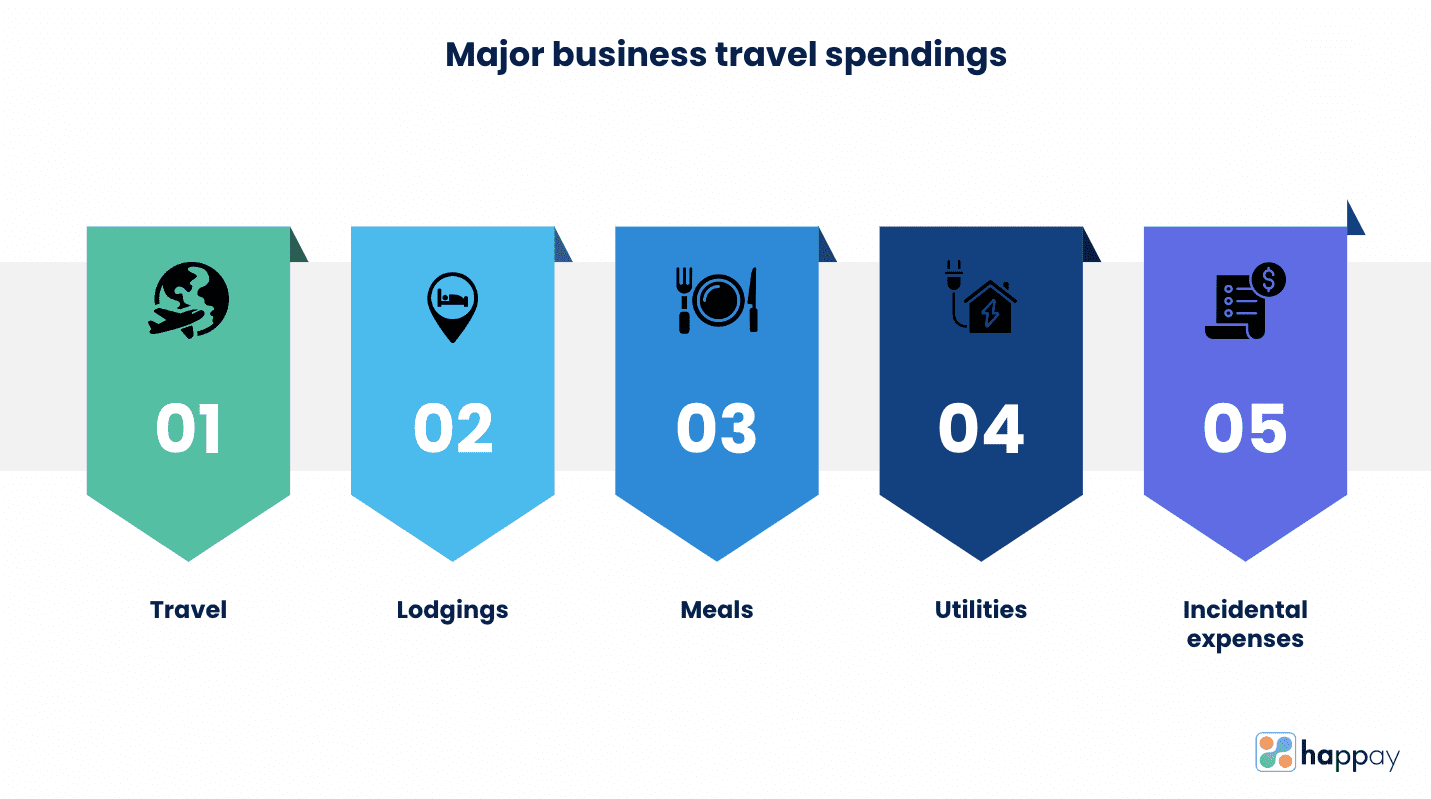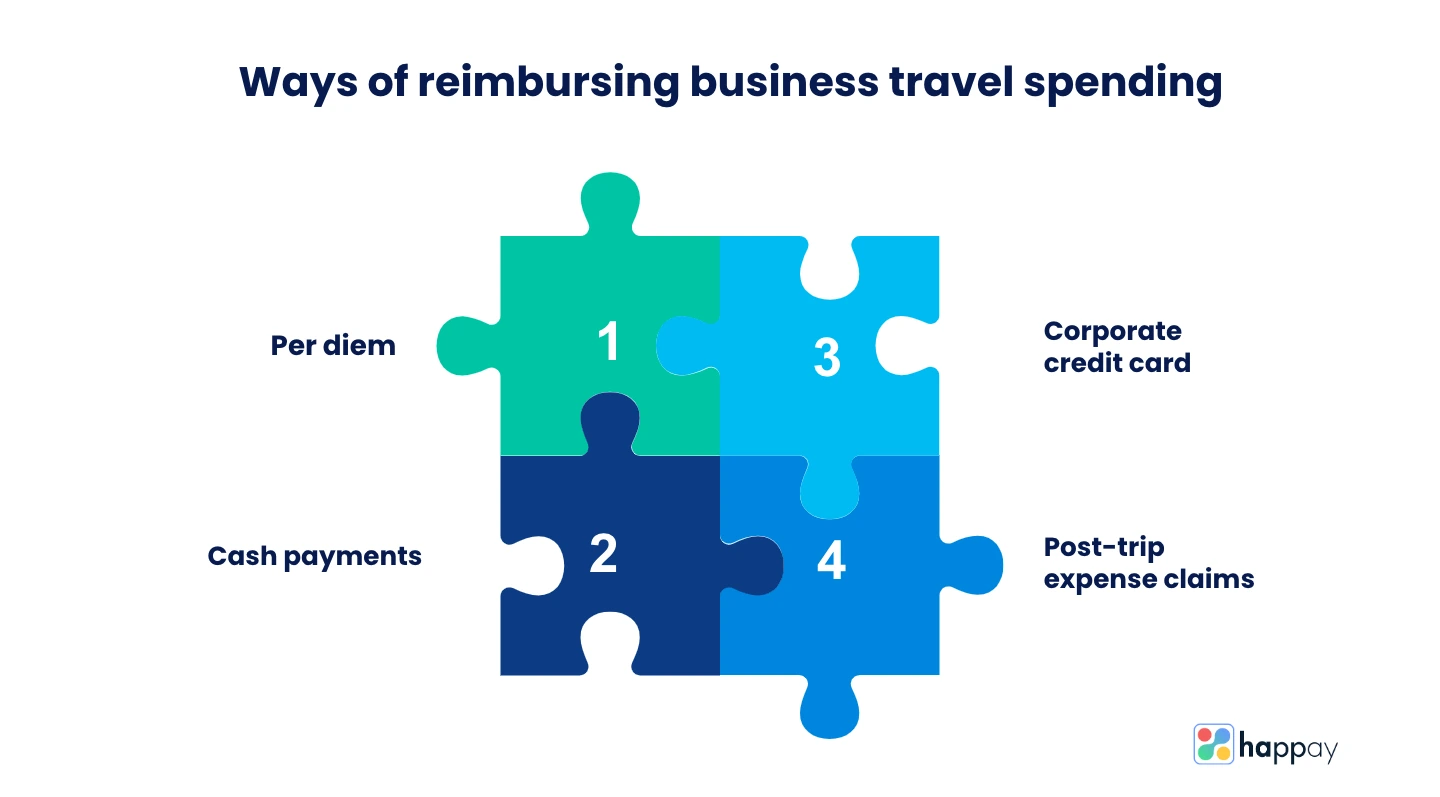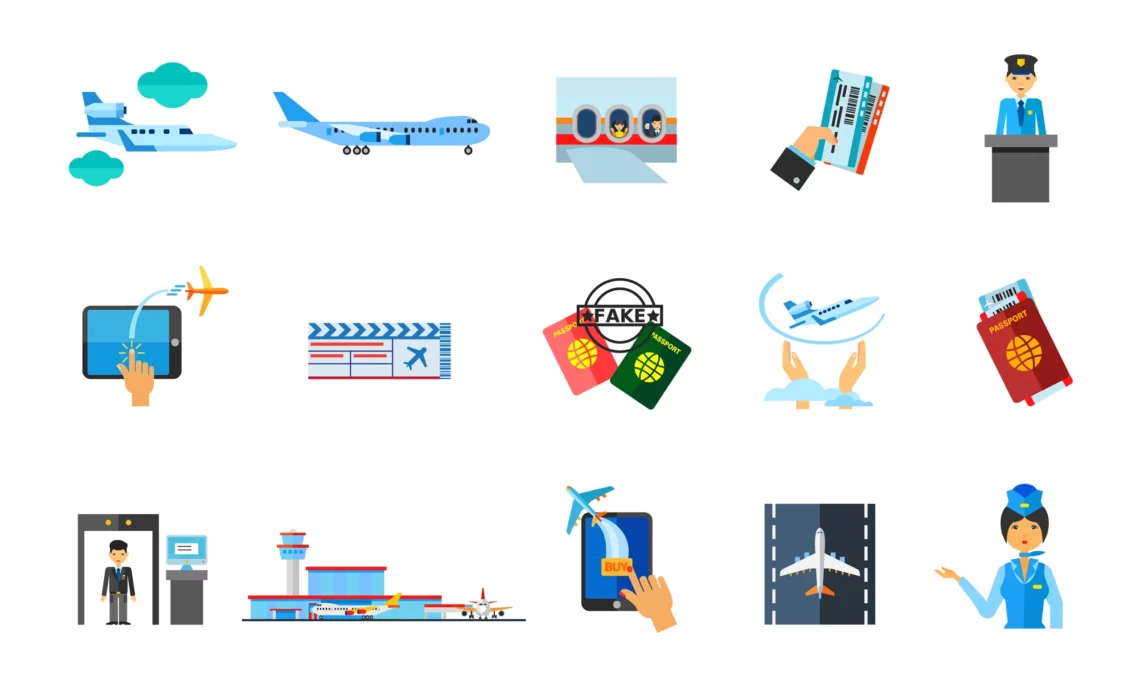Last Updated on November 28, 2025
Introduction
Every organization is trying to get the best clients, facilities, employees, and resources in the fast-paced, competitive, and cut-throat business world. This race for optimality is so heated that businesses surpass state and national boundaries to get the results they want.
While travel costs keep climbing in most countries, the need for business travel remains steady. Perhaps this is why the business travel industry is booming. Despite the pandemic, the total global business travel spending reached 697 billion US dollars in 2021, according to the Global Business Travel Association. Another study predicted that the business travel industry will grow by 21% in the post-covid scenario.
What is business travel spending?
Business travel spending is the money spent to facilitate all business travel activities. These activities include travel bookings, hotel reservations, meals, company meetings, event costs, etc.
Corporate travel is a significant expense for businesses today. Hence, companies must track and manage business travel spending to reduce costs and not waste money on unnecessary expenses.
How much do companies spend on business travel?
While the amount of business travel spending differs with the industry, the number of employees, country, and size of the business operation, we can still get a rough estimate of how much businesses spend on travel.
According to the New York Journal, companies spend about 10% of their revenue on travel-related expenses.
Read also – What are Business Expenses?
What are the main business travel spendings?

1. Travel
Transportation is one of the two most significant business travel expenses, especially if the employee travels by flight. However, depending on the distance of the destination and the urgency of the nature of the travel, the employee and the company can agree on other modes of transportation, like train and car. This can help lessen the expense burden on the company.
2. Lodgings
Depending on the destination and duration of stay, the cost of employee accommodations can add up to a considerable sum.
3. Meals
This is an unavoidable expense during business trips. Anything that the employee eats or drinks can be reimbursable according to your travel policy. However, companies can detail the type of reimbursable foods and beverages. For example, most companies do not reimburse employees for alcoholic beverages bought during the trip.
4. Utilities
Here are a few utilities that businesses pay for.
- Electricity
- Cooling and heating
- Water
- Phone bills (often chargeable and vary per the employee’s consumption), etc.
5. Incidental expenses
Incidental expenses may include the following costs.
- Laundry bills
- Staff tips
- Client gifts and meals
- Baggage handling fees
- Room service, etc.
What can’t be claimed as business travel spending?
Here are a few costs that cannot be claimed as business travel spending.
- Cost of using personal vehicles
- Expenses incurred by a personal companion
- Personal expenses like souvenirs or gifts for family and friends
- Unauthorized alcohol costs
Different Types of business travels
Business travel comes in various forms. The business travel expense for each trip depends on the type of business travel. Business trips can be individual and team-wide. They can be for strictly business purposes and also for recreational purposes. Let’s take a look at the most common types of business travel.
1. Client meetings
Salespeople or executives sometimes need to meet present or future clients in person. These clients are important customers whose account is essential for the business’ health, or it may just be a general company culture to close deals over face-to-face interactions.
In many cultures, it is essential for two parties to know and respect each other as individuals before they start doing business together. When clients belonging to this culture live in different cities or countries, business travel becomes a necessity.
2. Company retreats
Many organizations know the importance of kicking back and relaxing. So they invest a certain amount once or twice a year to take the entire team on a company retreat. This helps the employees unwind and bond with each other and improves their attitude towards the leadership.
3. Internal meetings and site visits
For companies with branches spanning multiple countries or cities, it is vital for the management and leadership to travel to different locations and ensure everything is in place. It is also essential for the workforce to interact directly with executives; hence, business travel is crucial in large organizations.
4. Conferences or trade fairs
Conferences are a way for businesses to learn about new opportunities, technology, and trends in their industry. They are essential for the creative and innovative growth of an organization.
Trade fairs are events that let companies showcase their products and services to potential customers. It is an essential sales channel for many companies as they help get the word out about new products, improve brand image and allow the salespeople to interact with prospects directly.
5. Transfers
Employees sometimes relocate to a branch in a different city or country. This can be because of personal reasons, promotions, or because the company has opened a new unit, and the employee is essential to its functioning. Transfers are long-term commitments and often come with other expenses like relocation allowances and long-term accommodation.
6. Bleisure
Recently, a new travel trend called ‘Bleisure’ has emerged. It combines business with leisure (hence the name) and is gaining popularity in the corporate world. Traveling employees often increase their stay to explore the destinations or reconnect with local acquaintances.
Allowing a leisure component on business trips can help the management encourage employees to volunteer for business trips more.
7. Employee training trips
Organizations sometimes take employees to specific sites and locations for training. All the money spent on transferring employees from the office location to the site is a part of business travel expenses.
Read also – A Guide to Spend Management
Who plans business travels?
The most stressful thing about traveling isn’t the commute or the stay; it is the planning. In the case of business travel, planning becomes even more of a hassle because multiple stakeholders come into the equation.
The planner must ensure that the travelers are as comfortable as possible within a specific budget. Depending on the requirement, companies have different ways to plan business travel.
a) In-house administrative staff
Many companies have their administrative staff make travel arrangements. Small businesses mostly opt for this as they have fewer employees to manage and a limited budget for business travel spending.
b) Travel management companies and corporate travel agencies
Some businesses outsource their business travel planning to travel management companies (TMCs) or corporate travel planners. TMCs help businesses save time by taking over tedious planning processes.
TMC professionals have inside information and know-how about the travel industry. They can plan trips for the whole team that fit the company’s budget and the quality of experience the employees expect. They also have vendor connections they can leverage to get you special discounts.
c) Employees using self-booking tools
Using self-booking tools is a wise option for large businesses that heavily invest in business travel and have many employees on the road every month. However, having employees self-book their trips can lead to many issues.
One of these issues is the breach of policy. An employee may not always be aware of the spending limits for a specific trip and end up overspending. This either means that the business suffers a budget leakage or the employee bears the brunt of it.
Reimbursement is another challenge of self-booking. Employees file for reimbursement and must wait for a while before their expense report is approved and validated. This may cause them frustration.
However, Happay’s self-booking tool, Happay Travel, tackles these issues by empowering your employees to self-book their trips. They get pre-spend violation alerts that help them limit their spending according to the travel policy. Happay Travel’s refund tracker feature also gives employees complete transparency over the progress of their reimbursement.
Read also – What is Spend Analysis?
How to manage business travel spending?
1. Construct a clear travel policy
A clear travel and expense policy is one of the most critical steps to curb corporate travel spend. The travel policy details the spending limits, the entire reimbursement process approval hierarchy, valid expense categories, best practices, code of travel conduct, dos and don’ts, etc.
Ambiguity in the travel policy can allow employees to indulge in malpractices like scams and expense fraud. Make sure your travel and expense policy leaves as little to interpretation as possible.
2. Communicate travel policy to employees
A travel policy can make no difference if the workforce is unaware of it. Ensuring all employees are updated with the policy guidelines boosts compliance and helps avoid miscommunication. It also shortens the travel planning time as employees don’t have to constantly email the management to understand what is okay and what isn’t.
3. Categorize travel bookings
Categorizing travel bookings according to travel requirements, budget, destination, type of spend, urgency, department, and project makes tracking, managing, and analyzing corporate travel spend easier.
4. Take measures to track spending in real-time
Tracking spending in real-time helps check the employees and prevent them from overspending. It also helps reduce expense fraud and speeds up the reimbursement process since expense validation becomes quicker.
5. Use automation to track spending and recognize trends
Using automation to track spending in real time helps curb travel spending and creates a data repository that you can use to analyze spending trends. This enables you to detect and eliminate cost leakages.
Knowing expense trends also helps you identify your company’s most frequent vendors and gives you more negotiating power.
6. Encourage employees to plan ahead and travel with notice
Knowing about travel requirements in advance helps make more cost-effective decisions during travel planning. Although some business trips are prompt and cannot be predicted, dates of events like trade fairs and conferences are announced months in advance, allowing you plenty of time to plan.
4 Ways of reimbursing business travel spends

1. Per diem
Per diem translates to ‘per day’ and is the predetermined daily allowance an employee gets to manage expenses on a trip. Per diem allowances are mostly given to travelers as an advance, but sometimes you can also get it after the trip.
2. Corporate Credit Card
Companies issue corporate credit cards to employees for all company-related expenses. Corporate credit cards allow real-time transaction visibility and reduce the need for the tedious expense claim and reimbursement process.
3. Cash Payments
Corporate credit cards cannot support all payments. Certain expenses like staff tips, stationery bills, or laundry fees require cash payments. So you can allot a certain cash amount for incidental expenses for the whole trip and give it to the employees. Ask the employees to maintain proof or receipts or all expenses and ask them to return the balance at the end of the trip.
4. Post-trip expense claims
It’s often difficult to predict the spending level of an employee before a business trip. Hence, the most popular way of managing travel spending is for employees to pay for all the expenses during the trip and file expense claims later.
How to track and calculate business travel spending?
You can track business travel spending using the following methods.
1. Spreadsheets
Maintain a list of all employee expenses on a spreadsheet. Ensure that this spreadsheet is updated regularly. All the entries should be validated after analyzing expense reports, invoices, bills, and receipts.
2. Using an automated expense management software or accounting system
Expense management platforms allow employees to scan and upload receipts on the go. They are more efficient and accurate in tracking expenses than spreadsheets or excel sheets. Automated software can also give you comprehensive insights on travel spending and help you calculate how much you spent on specific expense categories.
3. Using corporate or business credit cards
As discussed earlier, corporate credit cards automatically track and calculate all business travel-related transactions. You must get in touch with a bank and issue corporate credit cards for your organization.
Business Travel Spending: Challenges
When something is done at a large scale, challenges arise, more so when done manually. Let’s look at a few challenges businesses face that lead to business travel spending that is higher than necessary.
Challenges for Employees
1. Confusion regarding policies – Employees often do not understand the travel and expense policies, which leads to confusion during self-booking. This can cause them to take the wrong decisions and lead to losses through cancellations or budget leakage.
2. Traveling in unagreeable conditions to save money – Stringent spending limits may force employees to travel and stay in situations they are not comfortable in. In this case, businesses adopt a hybrid approach in which they allow employees a specific travel budget. Employees who want better facilities can cover the additional cost themselves.
However, it is best to optimize the cost of travel and get the best possible deals for the employees. This encourages them to volunteer to travel often and boosts morale.
4. Constant stress about saving bills and receipts – To receive reimbursement, traveling employees must create an expense report and present bills and receipts for validation. Maintaining a record of all the physical receipts is stressful. If the receipts get lost for some reason, the employees can miss out on reimbursement.
5. Incidental expenses – Incidental expenses are minor costs like laundry fees, baggage handling, staff tips, etc. It is hard to track them as employees often do not receive a receipt for them.
6. Delayed reimbursements – Expense approval and validation can take a long time, especially when done manually. This increases the financial burden on the employee.
Challenges for the Business
1. Expense frauds – Expense fraud is one of the worst issues businesses face. If a few malignant employees sense that there is scope for manipulation in the expense policy, they will do everything to take advantage of it.
2. Misreporting of expenses – Even if your employees are 100% honest and don’t intentionally overreport, they can still make an error while filing for expenses. This cannot only result in overspending but also skew future expense analyses.
3. Lack of insight into spending – Not having an accessible data record of business travel spending can cause problems during audits and tax filing. Additionally, as discussed, a lack of transparency in the expenditure can lead to employee expense fraud.
Read also – A Guide to Business Travel Cost
How to solve business travel spending challenges?
Travel and expense management software can solve employee and business issues. A T&E platform deploys automation to track and store expenses. It also enables real-time spend visibility and prevents expense fraud.
A travel expense solution can also help you optimize your travel costs by automating policy compliance, enabling pre-spend controls, and giving you higher negotiating power with vendors.
How to reduce business travel spending?
Business travel is a major company expense. Preventing it can save your organization hundreds of thousands of rupees. Let’s look at a few ways in which you can do it.
1. Set a travel budget
It is easier to control costs when you set travel spending boundaries. Assess your current travel booking workflows and past travel requirements. Talk to the most travel-intensive teams, like sales and marketing, to determine your business travel needs at the beginning of every month. Use this information to devise a budget for that month’s travel program.
Ensure that you factor all costs into the budget, including flight fare, accommodation, traveler safety, insurance, car rentals, visa fees, meals, entertainment, etc.
2. Book when the time is right
The flight tickets and hotel rates vary depending on the seasonality of travel. If you can plan in advance and book tickets and hotels in the off-season, you can save your organization a lot of money.
3. Take everyday measures to reduce expenses
You can encourage your employees to take on-trip measures to reduce expenses. Some of the steps they can take care-
- Using public transportation
- Avoiding overspending on client meetings
- Only spending on necessities
4. Invest in free cancelation plans
Business trips are unpredictable and often get canceled. The cancellation amounts are too high and often the entire cost of the booking. This is why you should invest in free cancellation plans.
5. Use a travel management company
Travel management companies specialize in getting you the best business travel deals. Investing in a travel management company doesn’t just save you money in the long run but also ensures that you and your employees don’t spend billable business hours on travel planning.
How can travel & expense management software reduce costs and improve efficiency?
A travel and expense management software is a tool that optimizes your expense management processes. It can be used to further reduce business travel spending and save hours and hours of manpower. Here is how a T&E solution can help you reduce costs and improve efficiency.
1. Automates expense claim creation
T&E management tools come equipped with unique receipt capture features and OCR technology that automatically captures expenses from receipts. All employees need to do is scan the receipts with their phone cameras, and the expense claim report gets created.
2. Automates approval workflows
Getting approvals for expense claims is a time-consuming process. It often takes weeks for managers to check and approve expense claims. A travel expense management platform can streamline this process by simplifying the claim validation process.
3. Unified communication
A lot of time is spent on email back-and-forths and lengthy phone calls during pre-trip activities like bookings and authorizations. A travel and expense management platform can unify all travel-related communication to one platform and avoid time wastage and confusion.
4. Reduced expense fraud frequency
Automation receipt capture, expense reconciliation, and report validation processes make it almost impossible for employees to commit expense fraud. This saves the company thousands, if not lakhs, of rupees that are otherwise spent reimbursing fraudulent claims.
5. Comprehensive insights into business travel spending
Automated travel and expense software ensures that all the recorded spend data is accurate and updated. This data is processed to create comprehensive reports that can give decision-makers insights into business travel spending and help them make the right financial decisions for the business.
Happay – The perfect software to reduce business travel spending
Happay’s AI-enables end-to-end expense management solution increases transparency during the approval process and accelerates reimbursement. This makes employees feel more comfortable spending their money on the business’s behalf. It also generates daily sales reports and facilitates efficient cost analyses.
Happay also has OCR technology, which extracts information directly from the receipts. This means no manual filing of expenses and no data contamination.
You can change how you tackle business travel spending and optimize your spending with Happay. Happy’s travel and expense management solution offers you all this and much more. Schedule a demo with the Happay team to learn more about the features and benefits of the platform.
FAQs
1. What are the more expensive business travel costs?
Transport and accommodation are generally the most expensive travel costs. Although, depending on the destination and duration of stay, this might change.
2. What is the best way to plan business travel?
For large businesses, outsourcing travel planning to a TMC or using a self-booking tool for employees is the best option. Manual processes can lead to issues like data contamination, misreporting, overspending, expense fraud, etc.
3. What is an example of business travel?
An employee traveling from one city to another to meet a client and pitch a product is an example of business travel.










Discussion about this post